Griffith Observatory
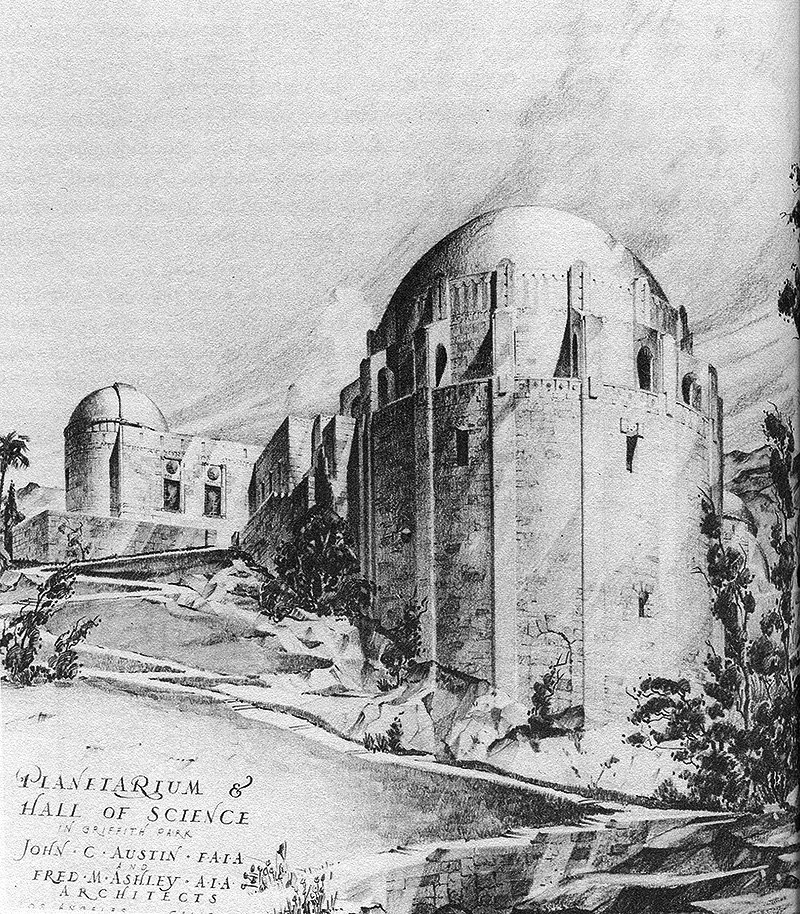 |
|
| (1932)^ - Sketch made by architect John C. Austin for a science facility. He later went on to design the iconic Griffith Observatory in Los Angeles. |
Historical Notes One night on Mt. Wilson about 1908, a short, powerfully built man with a handlebar mustache looked through the largest telescope in the world. What he saw transformed him, and would put Los Angeles at the forefront of a movement to make astronomy the people's science. We may never know whether Col. Griffith J. Griffith saw the rings of Saturn or another celestial object with the then-new 60-inch reflector telescope, but we can be sure that it inspired his vision of a world-class observatory for the people of Los Angeles, allowing the masses a glimpse of the heaven.* |
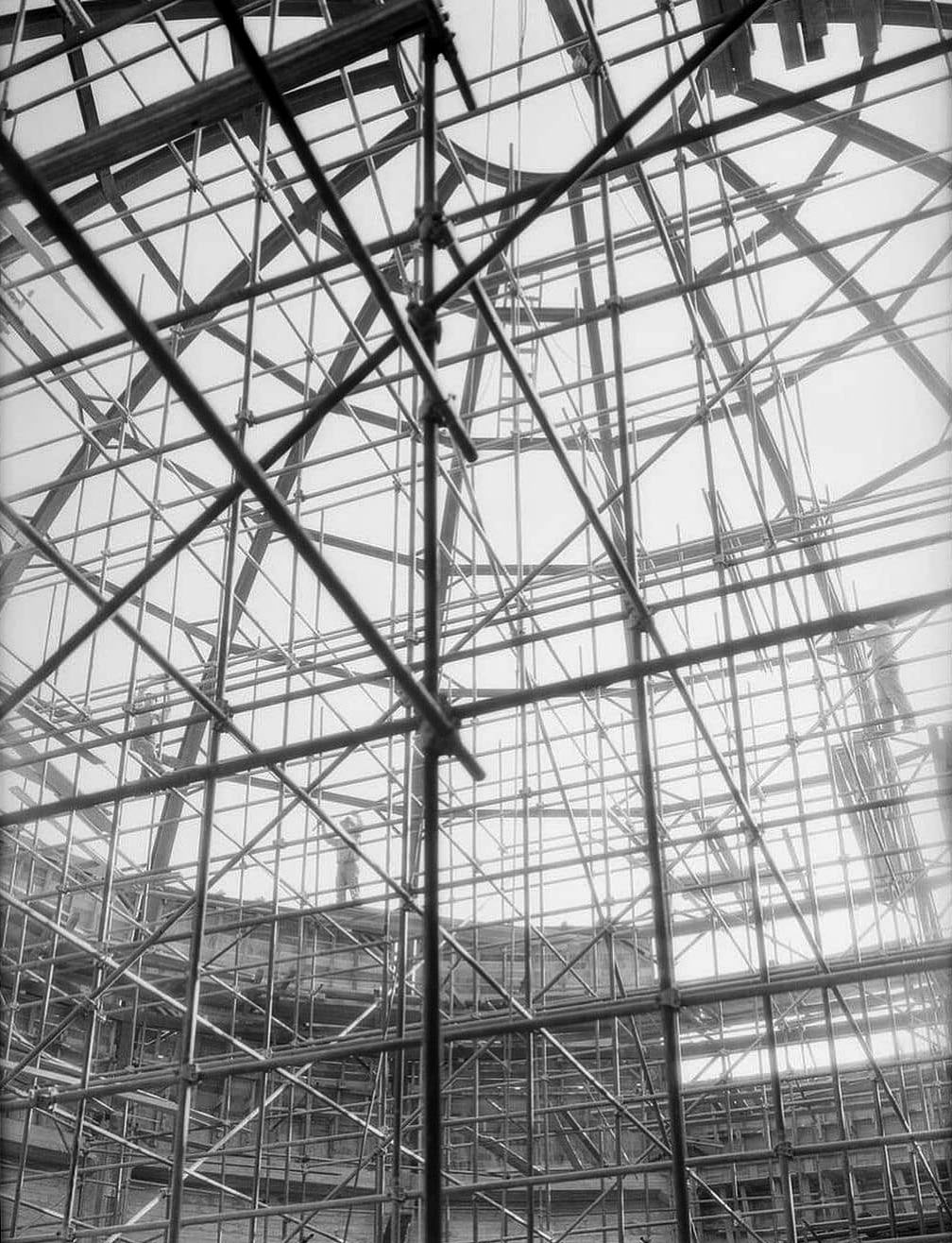 |
|
| (1933)* - Work begins on the Griffith Observatory dome. |
Historical Notes Construction began on June 20, 1933, using a design developed by architect John C. Austin based on preliminary sketches by Russell W. Porter. * |
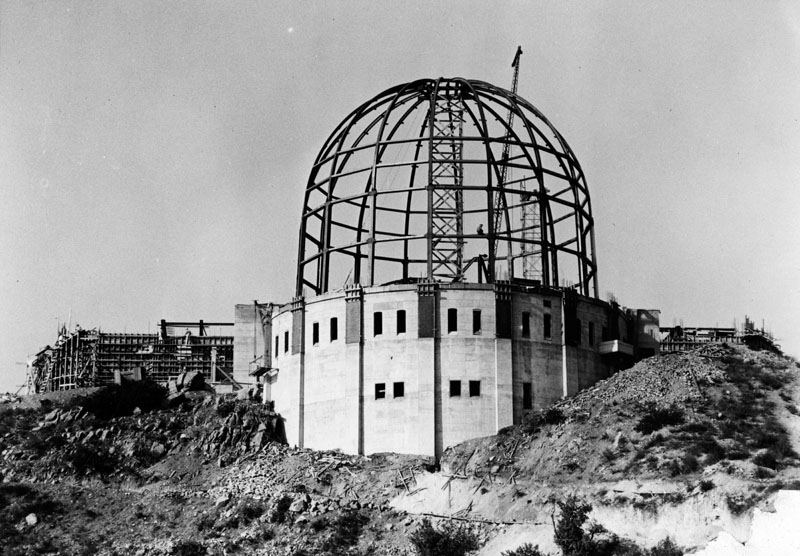 |
|
| (1933)* - A man sits on a steel girder on the half-completed dome of the Griffith Observatory as other construction workers are on scaffolds on the building behind the dome. Construction rubble is scattered around the Observatory's foundation. |
Historical Notes 3,015 acres of land surrounding the observatory was donated to the City of Los Angeles by Colonel Griffith J. Griffith on December 16, 1896. In his will Griffith donated funds to build an observatory, exhibit hall, and planetarium on the donated land. * |
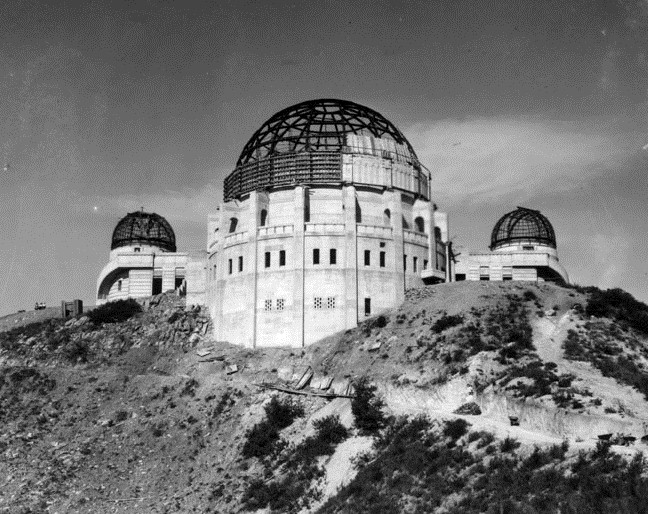 |
|
| (1934)* - The construction of Griffith Observatory in the final phases. The exterior domes can be seen here. |
Historical Notes Griffith Observatory was shaped not only by the minds of scientists but also by the times in which it was built. A major earthquake in Long Beach in March 1933 -- just as construction plans were being finalized -- led the architects to abandon the planned terra cotta exterior in favor of strengthening and thickening the building's concrete walls. Lower-than-usual prices caused by the Great Depression enabled the selection of the finest materials of the day for the interior walls, floors, and finishes, making the building both beautiful and durable.^ |
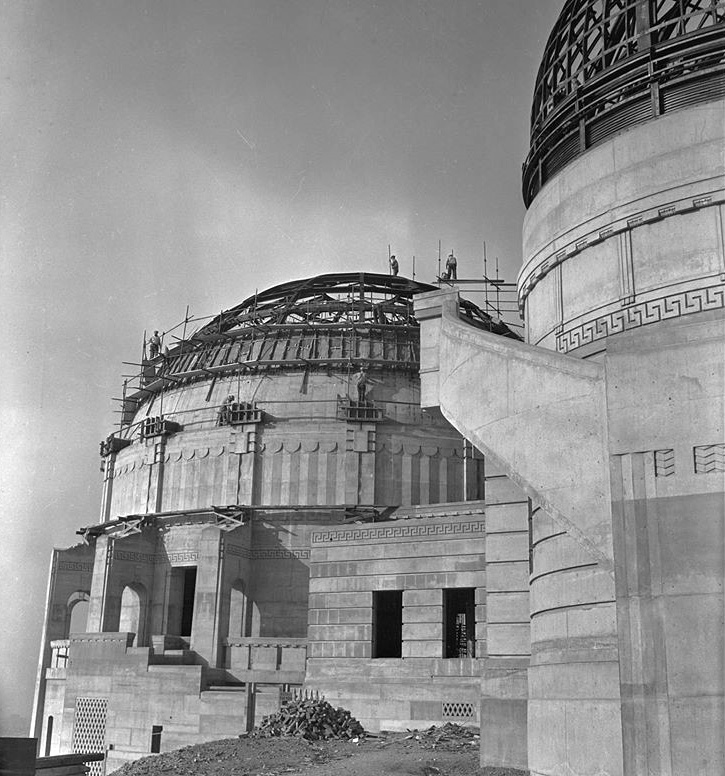 |
|
| (1934)**- View showing construction workers standing on scaffolding around the large dome of Griffith Observatory. Note the decorative design elements on the walls of the building. Photo courtesy of Los Angeles Times. |
Historical Notes The architects added a number of touches of Greek revival to the contemporary Art Deco style, such as fluting from the Greek classical orders. It also neatly pairs up with the Greek Theatre which was built nearby in 1929 as an open-air auditorium with a capacity of almost 6,000 seats.^ |
 |
|
| (1934)* - The Griffith Observatory and the main building, the planetarium, are seen from below and from the back. A hiking path has been cut into the hillside below, on the south side, but brush still covers much of the area. |
Historical Notes Griffith Observatory's unique architecture and setting, compelling programmatic offerings, and cinematic exposure have made it one of the most famous and visited landmarks in Southern California.^ |
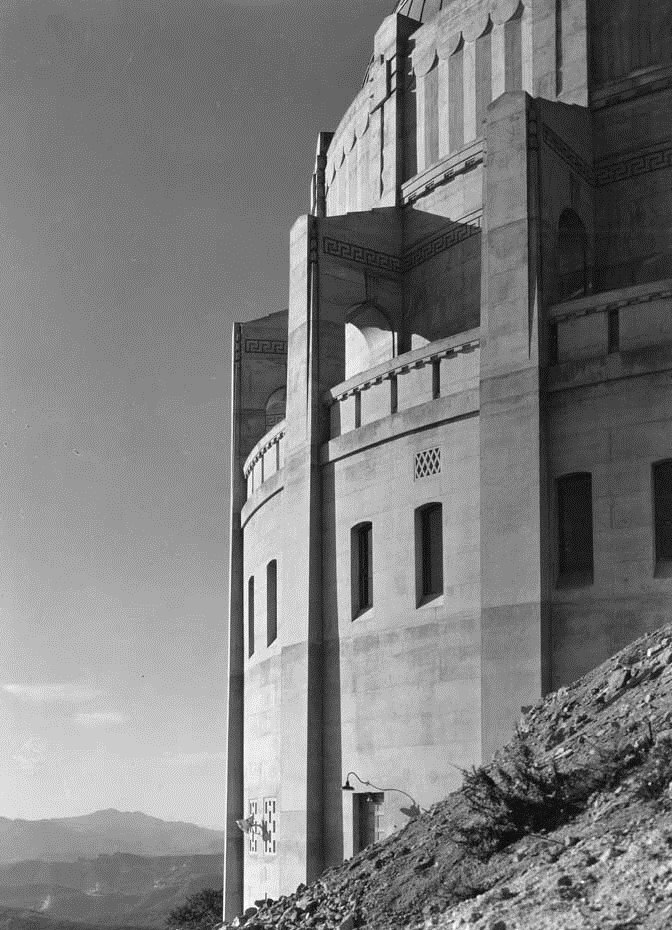 |
|
| (ca. 1934)^*# - Profile view of the Griffith Park Observatory on the Hollywood hillside. |
Historical Notes Caltech and Mount Wilson engineers drew up plans for the Observatory's fundamental exhibits: a Foucault Pendulum, a 38-foot-diameter model of a section of the Moon sculpted by artist Roger Hayward, and a "three-in-one" coelostat (three tracking mirrors on one mount to feed three separate solar telescopes) so that the public could study the Sun in the Hall of Science. The Trust judged the 12-inch Zeiss refracting telescope as the best commercially available instrument of its kind and selected it to be used as the public telescope. A 75-foot-wide theater --one of the largest in the world -- was designed to hold a Zeiss planetarium projector. The planetarium had been invented in 1923, four years after Griffith's death, and his family agreed with the Trustees that it more fully honored his intent than the originally planned cinematic theater. The Observatory's planetarium was the third to be completed in the United States.^ |
 |
|
| (1934)^.^ – Aerial view showing the Griffith Observatory under construction with the main building almost complete and the large dome surrounded by scaffolding. Note the construction of a large room at center of photo which will not be visible once the observatory is completed. The square object at right is the scaffolding for the Astronomers Monument. |
Historical Notes The observatory and accompanying exhibits would be opened to the public on May 14, 1935. On that day, the Griffith Trust transferred ownership of the building to the City of Los Angeles; the City's Department of Recreation and Parks (called the Department of Parks at the time of the transfer) has operated the facility ever since.^ |
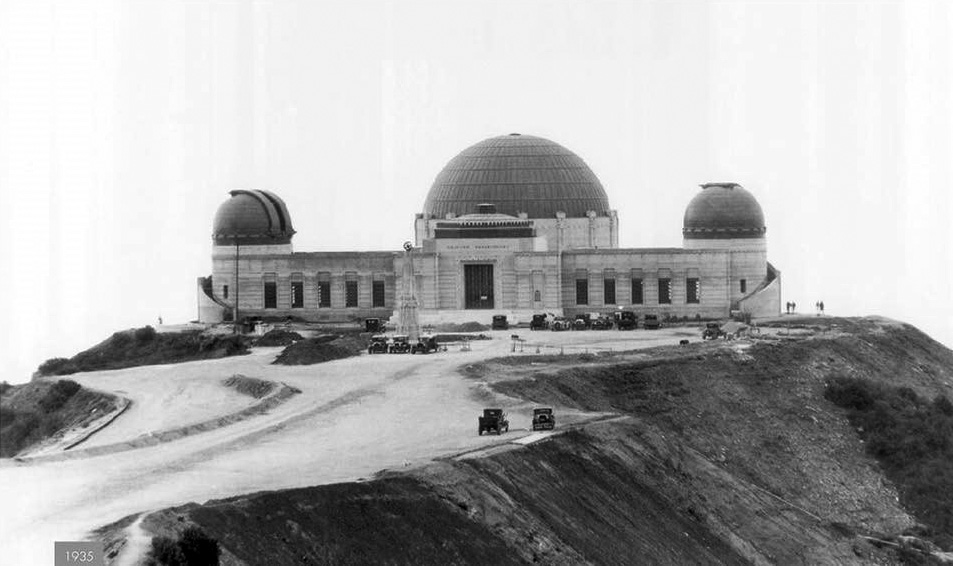 |
|
| (1935)^.^ - Griffith Observatory under construction but nearing completion. Construction began on June 20th 1933, and it opened May 14th 1935. |
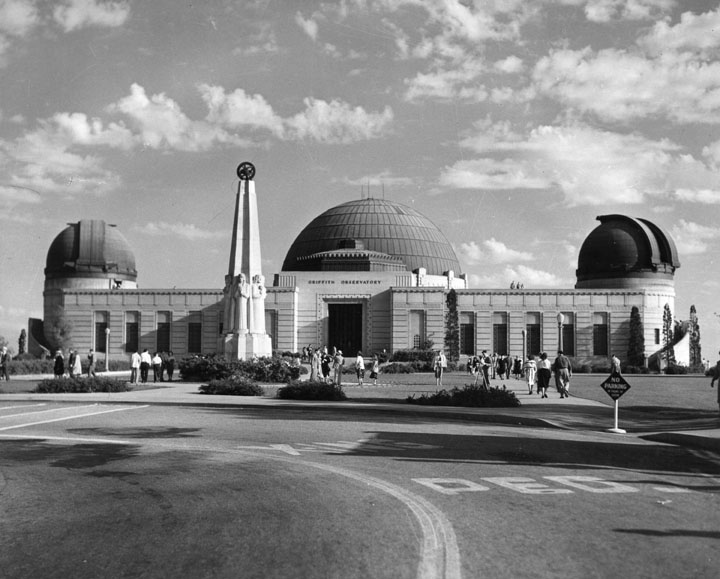 |
|
| (1936)* - View of the Griffith Park observatory and planetarium with the Astronomers Monument. Several people are on the walks, coming and going to the planetarium (the central section of the building). The domes on the left and the right ends of the building contain the triple-beam solar telescope and the 12-inch Zeiss Refracting Telescope respectively. |
Historical Notes The Astronomers Monument on the front lawn of Griffith Observatory pays homage to six of the greatest astronomers: Hipparchus, Copernicus, Galileo, Kepler, Newton, and Herschel. Artist Archibald Garner designed the sculpture commissioned by the Public Works of Art Project (PWAP). Garner worked with five other artists (each responsible for sculpting one astronomer) including George Stanley responsible for the "Oscar" statuette. The monument was dedicated November 25, 1934, six months before the Observatory opened.* |
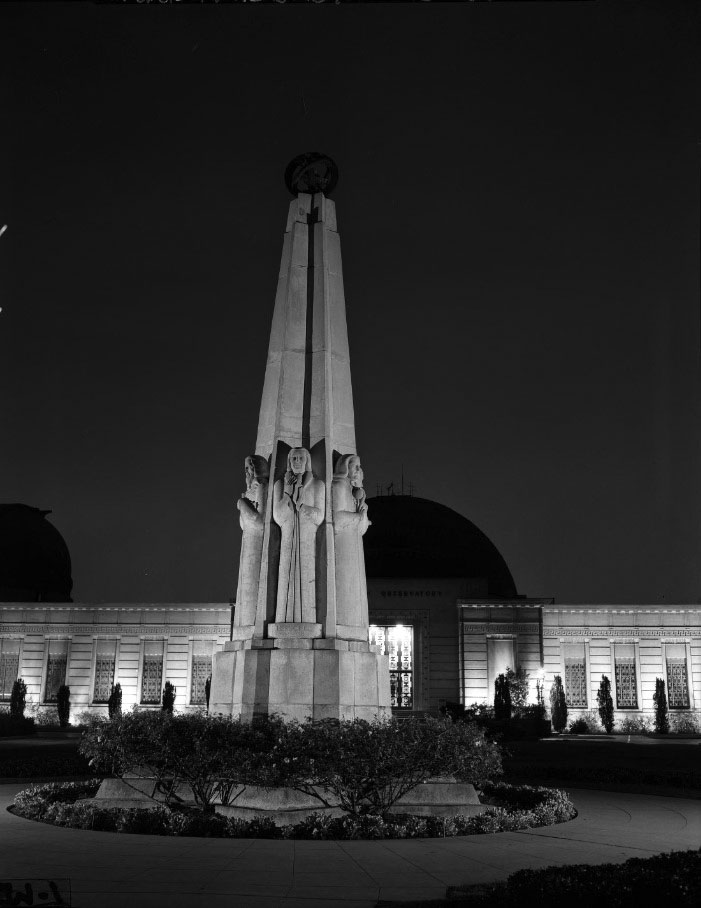 |
|
| (ca. 1940)^ - Nightime view showing the obelisk-shaped Astronomers Monument by the front entrance of the Griffith Observatory and Planetarium. |
Historical Notes The six astronomers featured on the monument are among the most influential and important in history. Albert Einstein was considered for inclusion, but planers ultimately decided it would be inappropriate to feature someone still alive (The monument was completed in 1934; Einstein died in 1955).* |
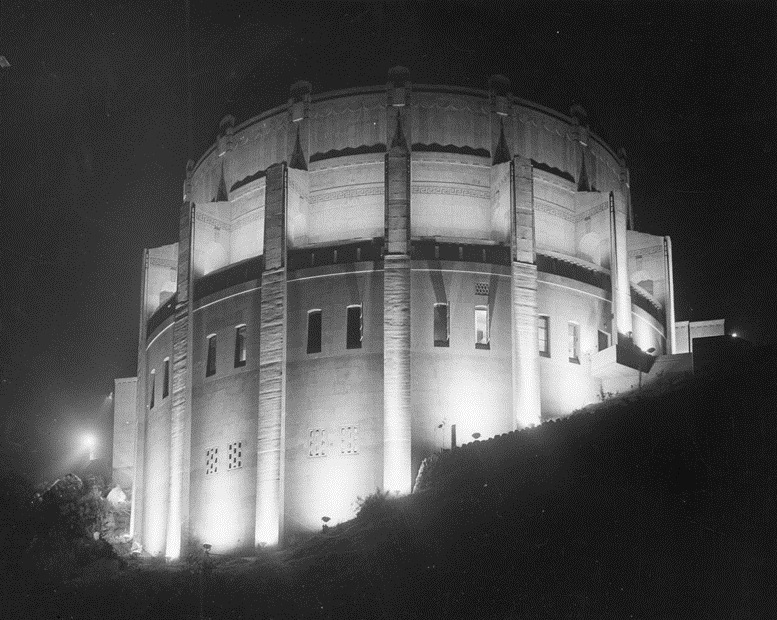 |
|
| (1935)^*# - The iconic Griffith Observatory stands out in its brilliance as it is illuminated in the Hollywood Hills. |
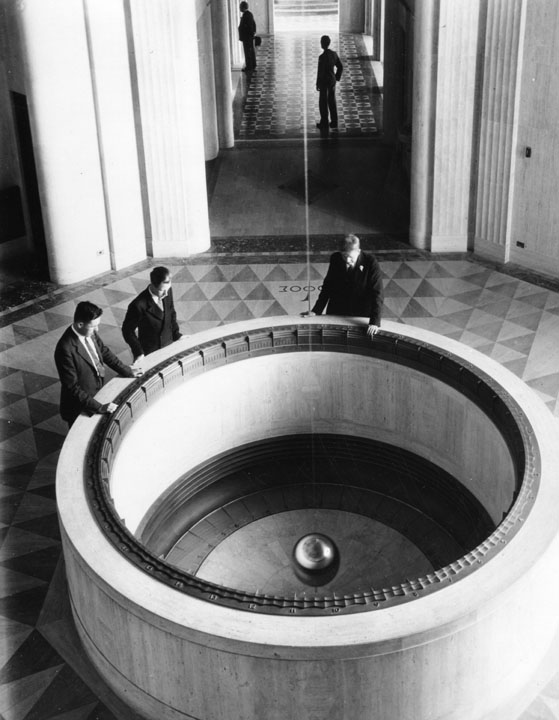 |
|
| (ca.1935)* - Three men gaze at the Foucault pendulum in the foyer of the Griffith Observatory. The pendulum demonstrates the rotation of the earth. |
Historical Notes The first exhibit visitors encountered was the Foucault pendulum, which was designed to demonstrate the rotation of the Earth. |
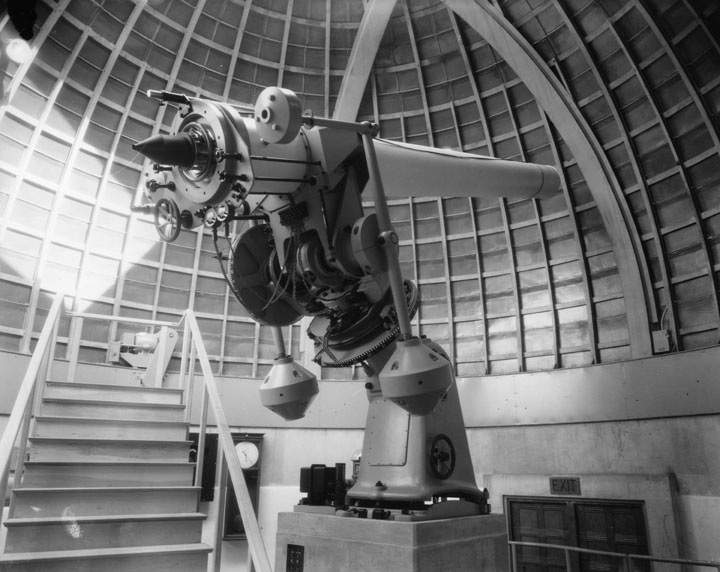 |
|
| (ca. 1935)* - View of the 12-inch telescope located within one of the two smaller domes at the end of the Griffith Observatory. |
Historical Notes The genesis of Griffith Observatory's public telescope occurred when Griffith J. Griffith was invited to visit to Mount Wilson Observatory, then home to the world's largest operating telescope, the 60-inch reflector. While there, he was given the opportunity to view a celestial wonder through the telescope. Profoundly moved by the experience, Griffith seized on the idea of constructing a public observatory with a telescope that could be used by all residents of Los Angeles. He specified in his will that the telescope was to be "at least 12-inches in diameter" and "complete in all its details" and was to be located "high and above the Hall of Science." In 1931, the Griffith Trust ordered the telescope from the Carl Zeiss Company of Jena, Germany; the $14,900 spent on the instrument was the first purchase of material for Griffith Observatory.^ |
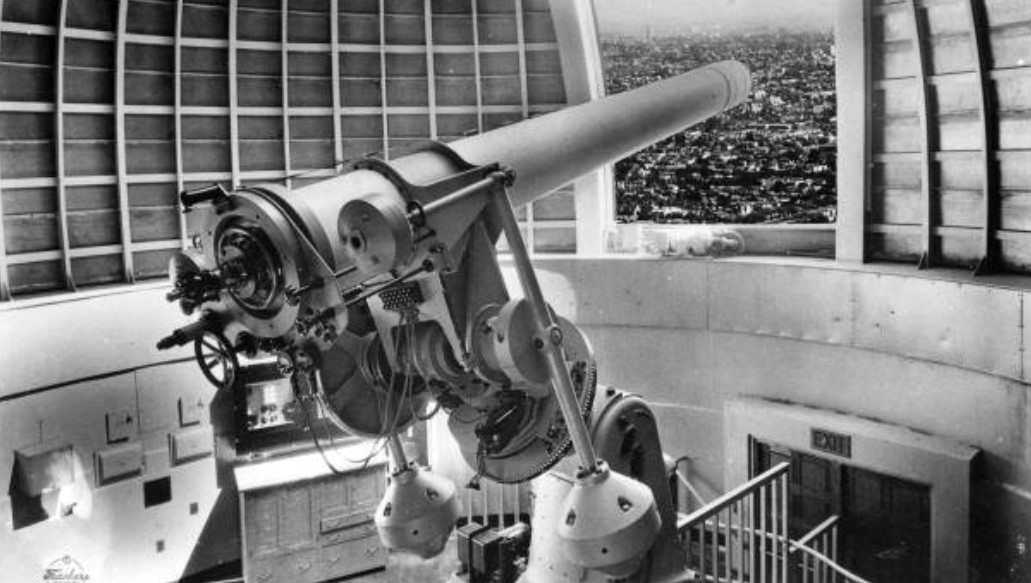 |
|
| (ca. 1936)* - The 12-inch Zeiss refracting telescope with dome opened for viewing. |
Historical Notes Since opening in 1935, more than seven million people have put an eye to Griffith Observatory's original 12-inch Zeiss refracting telescope. More people have looked though it than any other telescope in the world.^ |
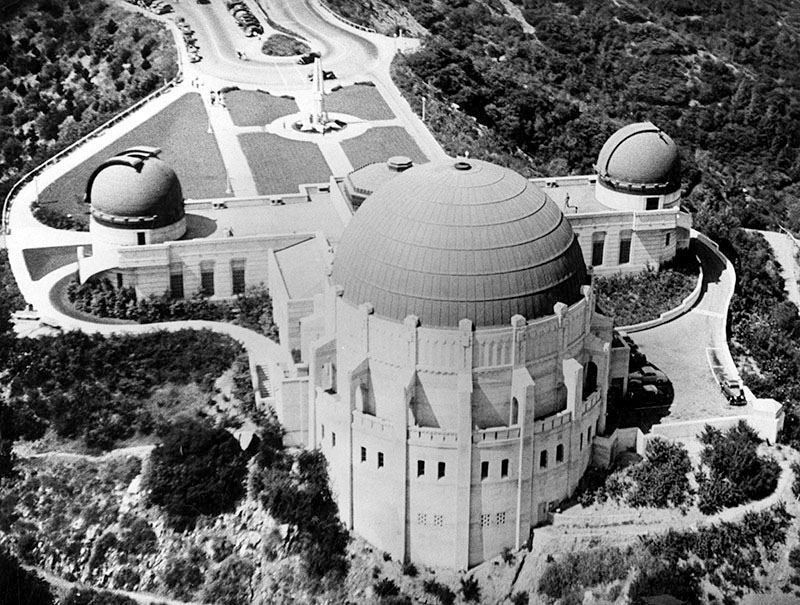 |
|
| (1938)* – Aerial view showing the symmetry of the beautiful art-deco Griffith Observatory. |
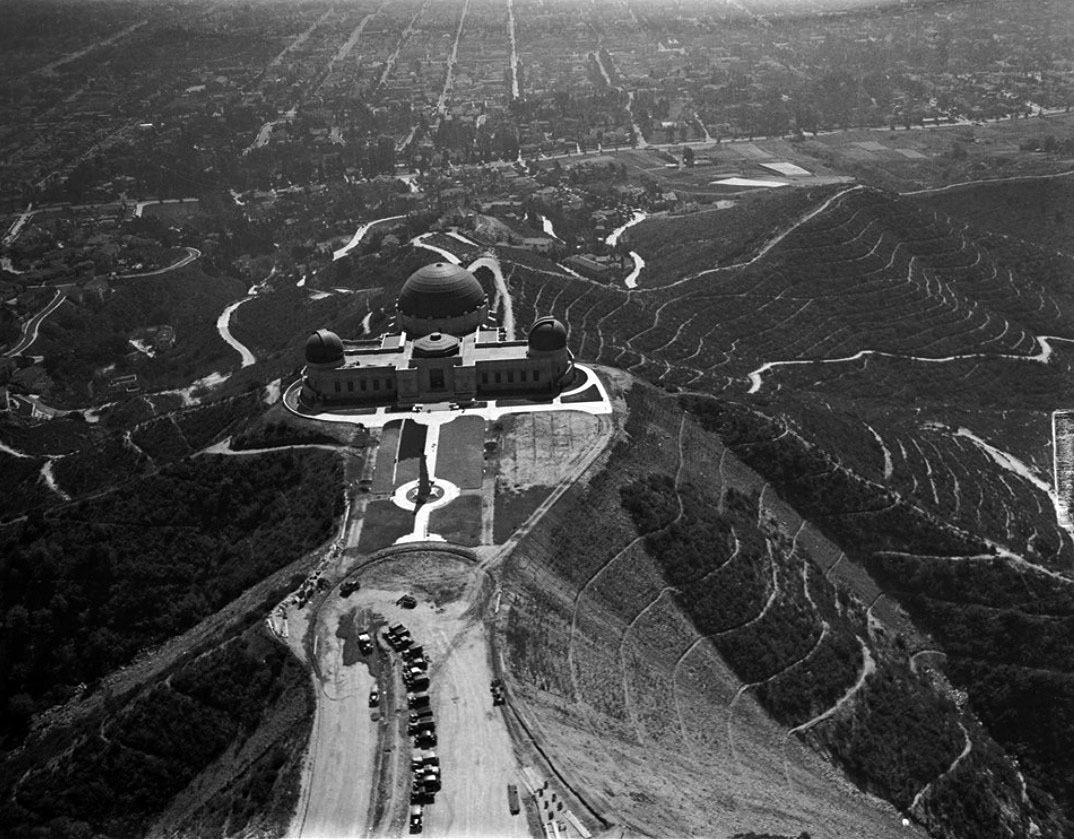 |
|
| (1933)^.^ – Aerial view looking down at a nearly completed Griffith Observatory. Note the channel terraces on the hillside. |
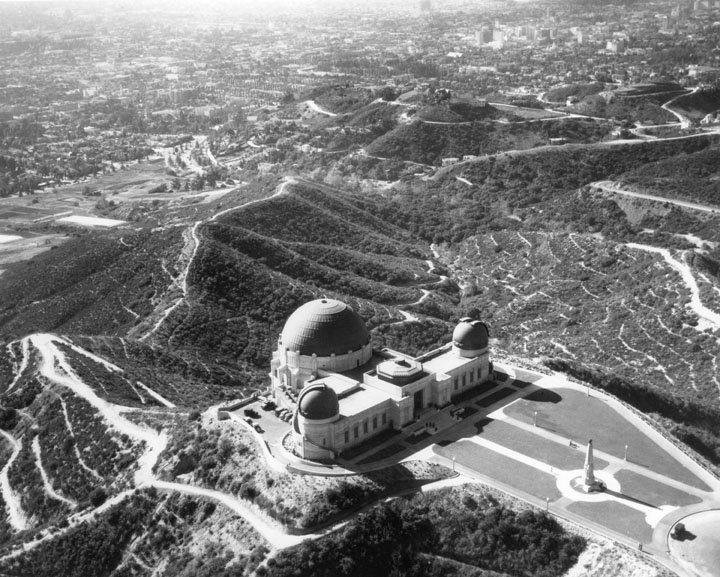 |
|
| (1935)* - Aerial view of the top and front view of the observatory/planetarium. The Astronomers Monument, designed by Archibald Garner, is out front on the well manicured front lawn, and some parking with cars is seen around the back side (probably for the staff). Behind the planetarium are the tree covered hills and farther back the beginnings of buildings and homes in Hollywood. |
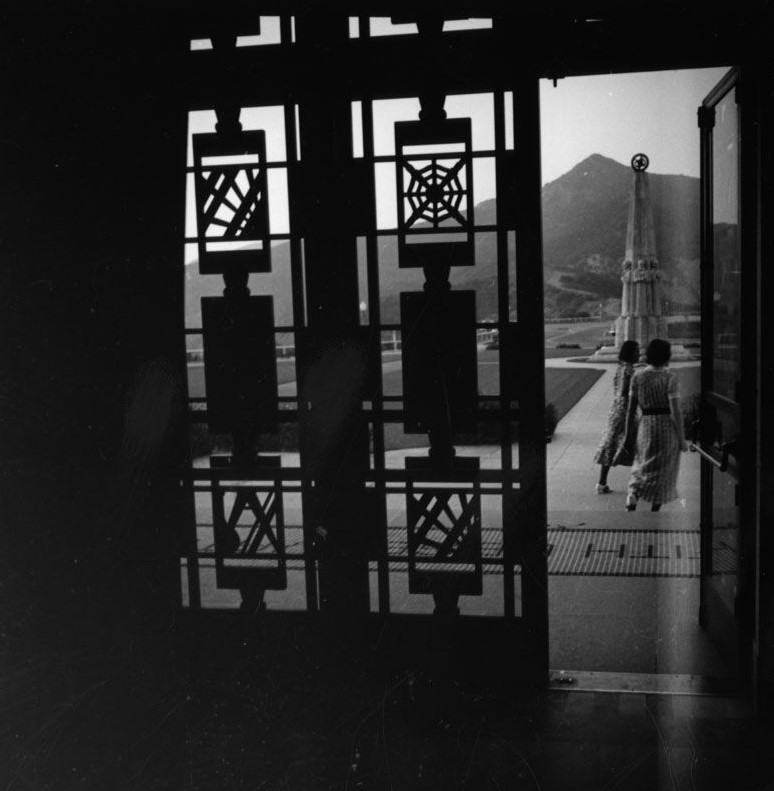 |
|
| (ca.1937)* – View looking out through the front doors of the Griffith Observatory with two women appearing to be walking out. The Astronomers Monument stands tall behind them and Mt. Hollywood peak can be seen in the distance. |
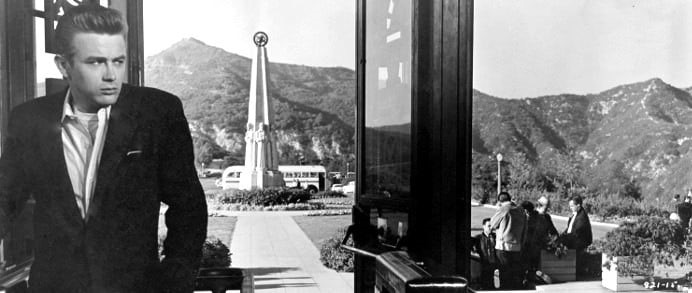 |
|
| (1955)* - All alone. Production still of James Dean during filming of "Rebel Without a Cause", Griffith Observatory. |
Historical Notes The Griffith Observatory has appeared in numerous TV shows and films, including two major sequences of Rebel Without a Cause (1955), starring James Dean and Natalie Wood. A bust of James Dean is located at the west side of the observatory grounds. Other observatory film appearances include La La Land (2016), The Terminator (1984), The Rocketeer (1991), The People vs. Larry Flynt (1996), and Transformers (2007).* |
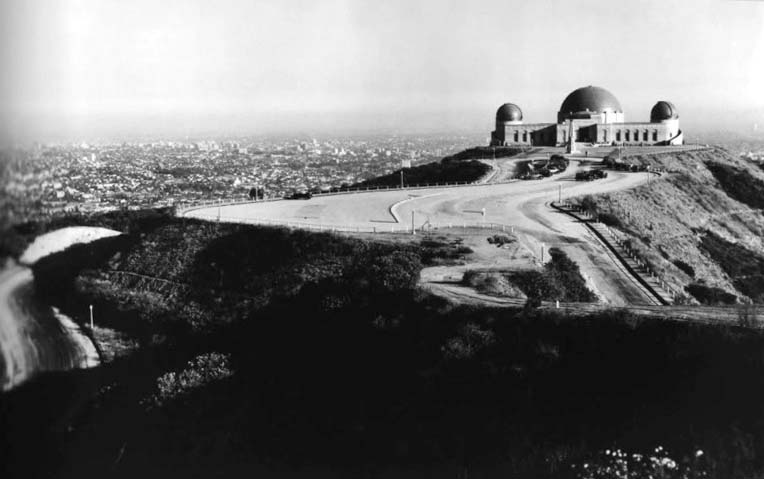 |
|
| (1930s)**^ – View of the Griffith Park Observatory on a clear day with the Los Angeles cityscape in the background. Several cars are parked in front of the observatory. |
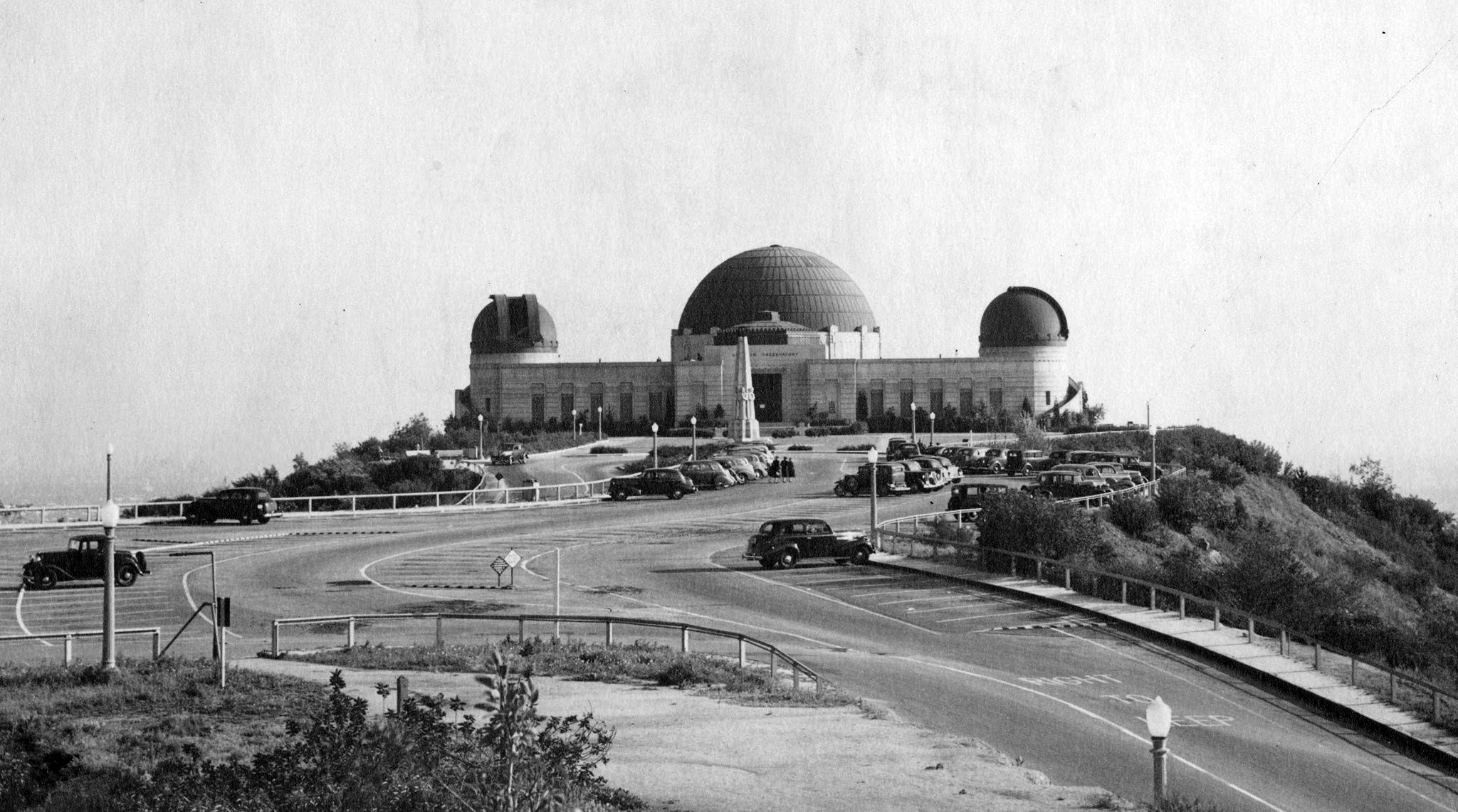 |
|
| (ca. 1938)^.^ – View showing the Griffith Observatory on a hazy day. |
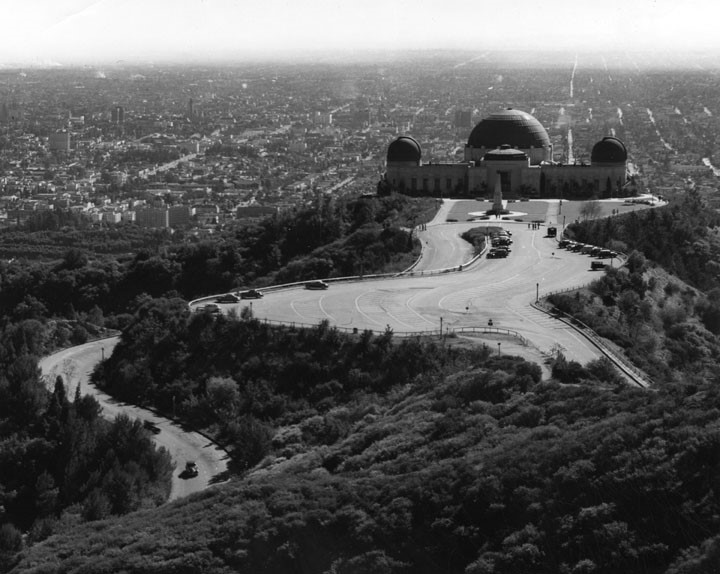 |
|
| (ca. 1943)* - Seen from a nearby (trail to Mt. Hollywood) hillside is the front of the planetarium, the lawn and parking lot, and road leading down from the Griffith Observatory. Los Feliz, East Hollywood, Hollywood and greater Los Angeles is visible in the distance. |
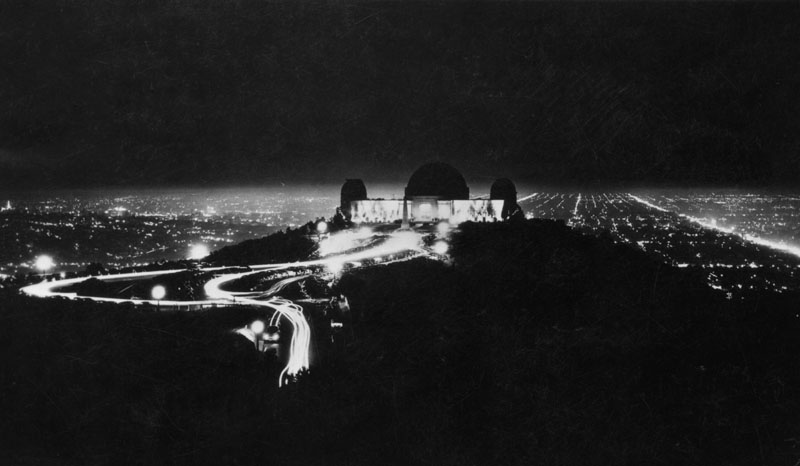 |
|
| (1940)* - Outline of Griffith Observatory is silhouetted against the brilliance of Hollywood lights. Night view taken from Mt. Hollywood. |
Historical Notes Since the observatory opened in 1935, admission has been free, in accordance with Griffith's will.*^ |
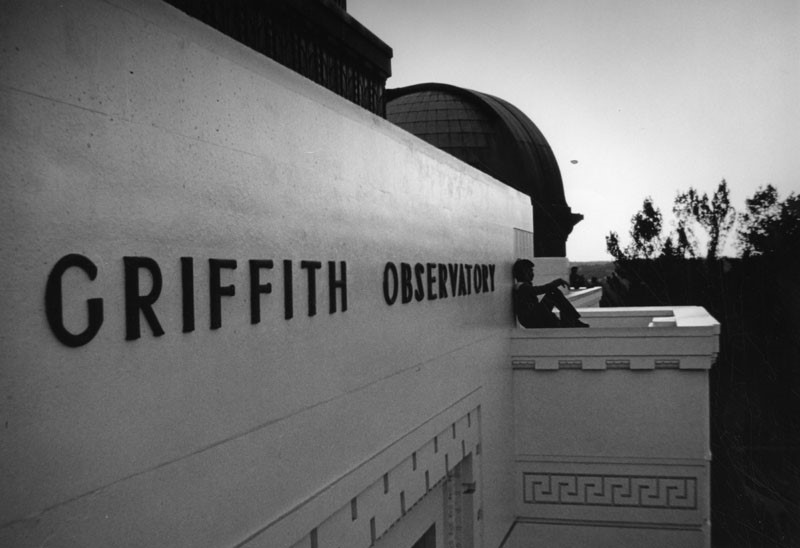 |
|
| (1978)* - A young man sits at one of many view points at the Griffith Observatory at sunset time. |
Historical Notes In 1976, the Griffith Observatory was designated Los Angeles Historic-Cultural Monument No. 168 (Click HERE for complete listing). In 2002, the observatory closed for renovation and a major expansion of exhibit space. It reopened to the public on November 3, 2006, retaining its art deco exterior. The $93 million renovation, paid largely by a public bond issue, restored the building, as well as replaced the aging planetarium dome.*^ |
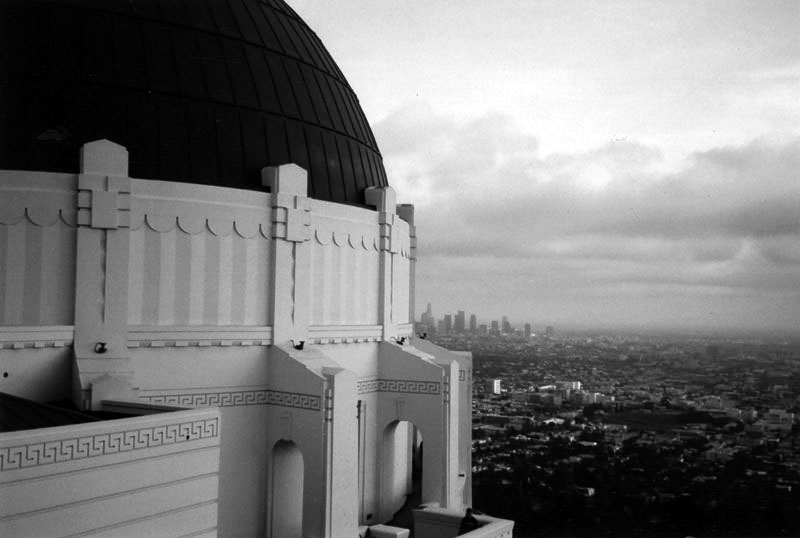 |
|
| (ca. 2006)* - Panoramic view of Los Feliz, Hollywood and downtown Los Angeles, taken from outside of the Samuel Oschin Planetarium at Griffith Observatory. |
Historical Notes For over 70 years, the planetarium has been used to present astronomical programs overseen by a lecturer. The view reveals a variety of buildings, homes and the numerous skyscrapers located in Downtown L.A. in the background. This photograph was taken not long after the observatory reopened on November 3, 2006, after having been closed since 2002 for an extensive renovation. John C. Austin and Frederick M. Ashley were the original architects of the Art Deco structure.* |
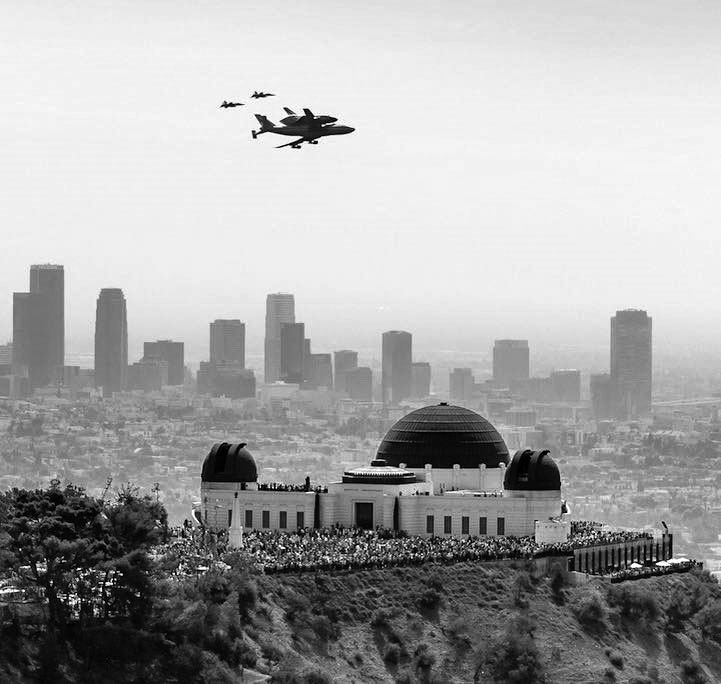 |
|
| (2012)^.^ – View showing Space Shuttle Endeavour atop of its 747 carrier aircraft being transported to LAX as it flies over the Griffith Observatory with the downtown skyline in the background. Note the large crowd of people in and around the Observatory, there to witness Endeavour’s “last flight”. Photo courtesy of Los Angeles Times - Framework |
Historical Notes After low level flyovers above NASA and civic landmarks across the country and in California, Endeavor was delivered to Los Angeles International Airport (LAX) on September 21, 2012. The orbiter was slowly and carefully transported through the streets of Los Angeles and Inglewood three weeks later, from October 11–14 along La Tijera, Manchester, Crenshaw, and Martin Luther King, Jr. Boulevards to its final destination at the California Science Center in Exposition Park. |
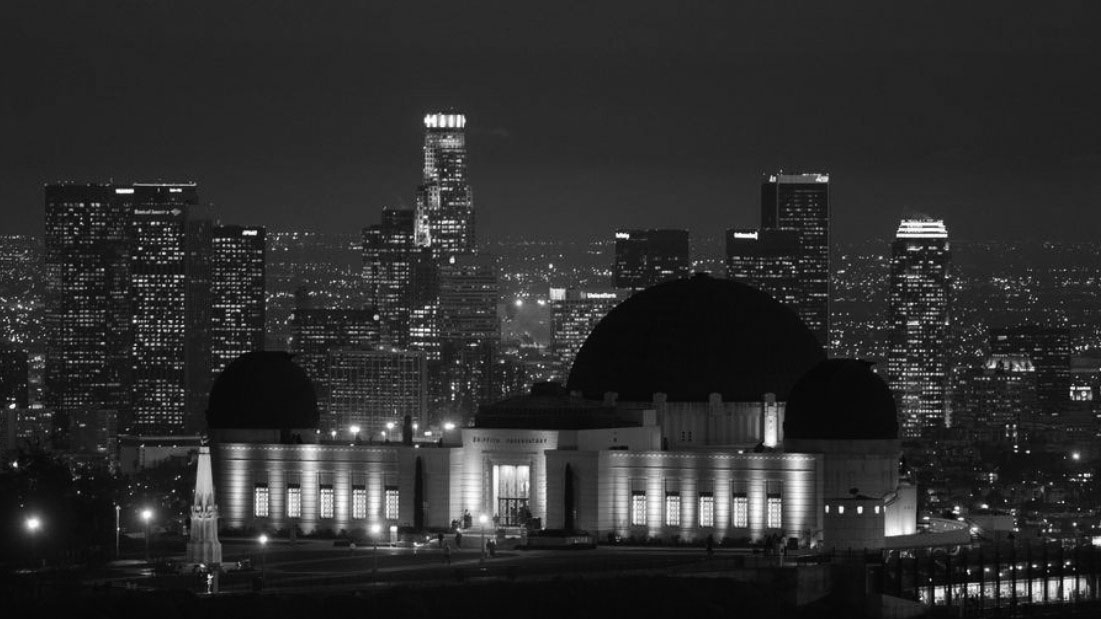 |
|
| (2015)#* - Griffith Observatory through a telephoto lens with Downtown Los Angeles in the background. Photo by Wally Skalij, Los Angeles Times |
* * * * * |
|
Other Sections of Interest |
|
Water and Power in Early LA |
|
Newest Additions |
New Search Index |

A new SEARCH INDEX has been added to help navigate through the thousands of topics and images found in our collection. Try it out for a test run.
Click HERE for Search Index |
* * * * * |
< Back
Menu
- Home
- Mission
- Museum
- Major Efforts
- Recent Newsletters
- Historical Op Ed Pieces
- Board Officers and Directors
- Mulholland/McCarthy Service Awards
- Positions on Owens Valley and the City of Los Angeles Issues
- Legislative Positions on
Water Issues
- Legislative Positions on
Energy Issues
- Membership
- Contact Us
- Search Index
© Copyright Water and Power Associates
Layout by Rocket Website Templates